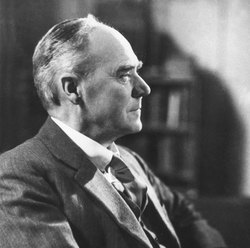Geoffrey Ingram Taylor
| Sir Geoffrey Ingram Taylor | |
|---|---|

Sir Geoffrey Ingram Taylor
|
|
| Born |
7 March 1886 St. John's Wood, Middlesex, England |
| Died | 27 June 1975 (aged 89) Cambridge, Cambridgeshire, England |
| Nationality | British |
| Fields |
Physics Mathematics Fluid mechanics Fluid dynamics Solid mechanics Wave theory |
| Alma mater | Trinity College, Cambridge |
| Academic advisors | J. J. Thomson |
| Doctoral students |
George Batchelor Francis Bretherton Walter Freiberger Rosa Morris |
| Known for |
Taylor cone Taylor dispersion Taylor number Taylor vortex Taylor–Couette flow Taylor–Goldstein equation Rayleigh–Taylor instability Taylor–Proudman theorem Taylor–Green vortex Taylor microscale Taylor column Double-slit experiment |
| Notable awards |
Knight Bachelor Royal Medal (1933) Copley Medal (1944) Order of Merit Wilhelm Exner Medal (1954) De Morgan Medal (1956) Timoshenko Medal (1958) Franklin Medal (1962) FRS Theodore von Karman Medal (1969) |
Sir Geoffrey Ingram Taylor OM (7 March 1886 – 27 June 1975) was a British physicist and mathematician, and a major figure in fluid dynamics and wave theory. His biographer and one-time student, George Batchelor, described him as "one of the most notable scientists of this (the 20th) century".
Taylor was born in St. John's Wood, London. His father, Edward Ingram Taylor, was an artist, and his mother, Margaret Boole, came from a family of mathematicians (his aunt was Alicia Boole Stott and his grandfather was George Boole). As a child he was fascinated by science after attending the Royal Institution Christmas Lectures, and performed experiments using paint rollers and sticky-tape. Taylor read mathematics at Trinity College, Cambridge.
His first paper was on quanta showing that Young's slit diffraction experiment produced fringes even with feeble light sources such that less than one photon on average was present at a time. He followed this up with work on shock waves, winning a Smith's Prize. In 1910 he was elected to a Fellowship at Trinity College, and the following year he was appointed to a meteorology post, becoming Reader in Dynamical Meteorology. His work on turbulence in the atmosphere led to the publication of "Turbulent motion in fluids", which won him the Adams Prize in 1915.
In 1913 Taylor served as a meteorologist aboard the Ice Patrol vessel Scotia, where his observations formed the basis of his later work on a theoretical model of mixing of the air. At the outbreak of World War I, he was sent to the Royal Aircraft Factory at Farnborough to apply his knowledge to aircraft design, working, amongst other things, on the stress on propeller shafts. Not content just to sit back and do the science, he also learned to fly aeroplanes and make parachute jumps.
...
Wikipedia
